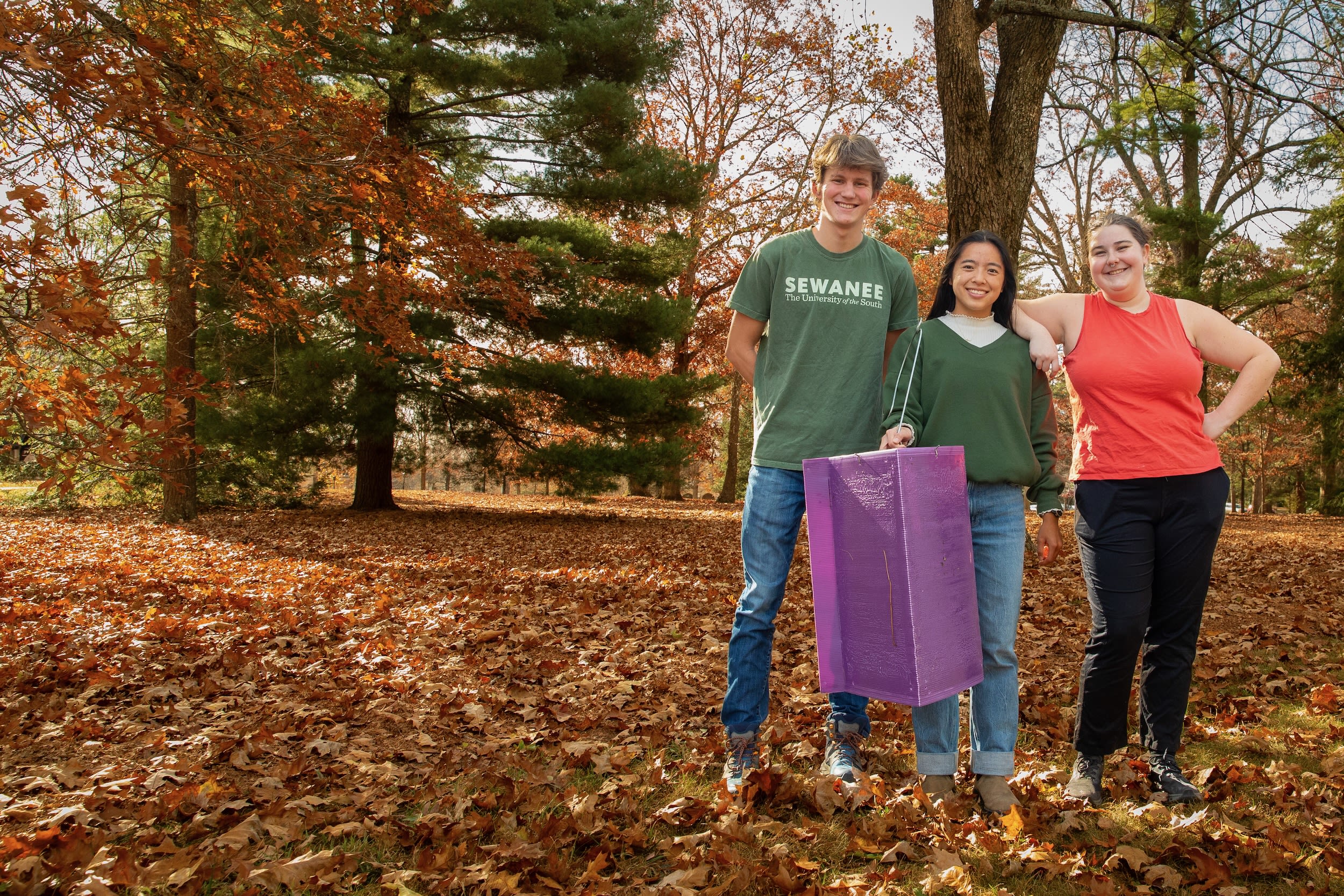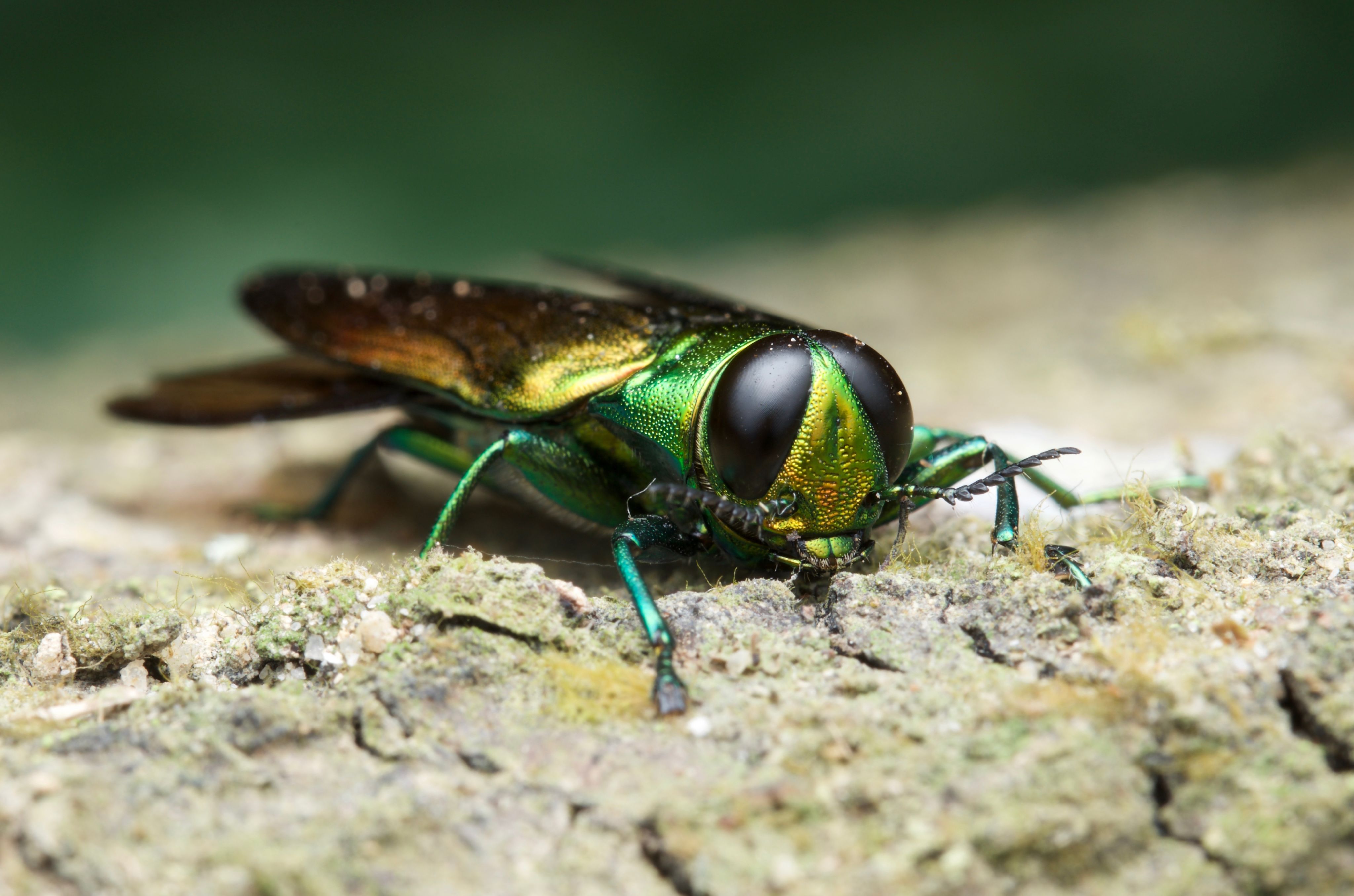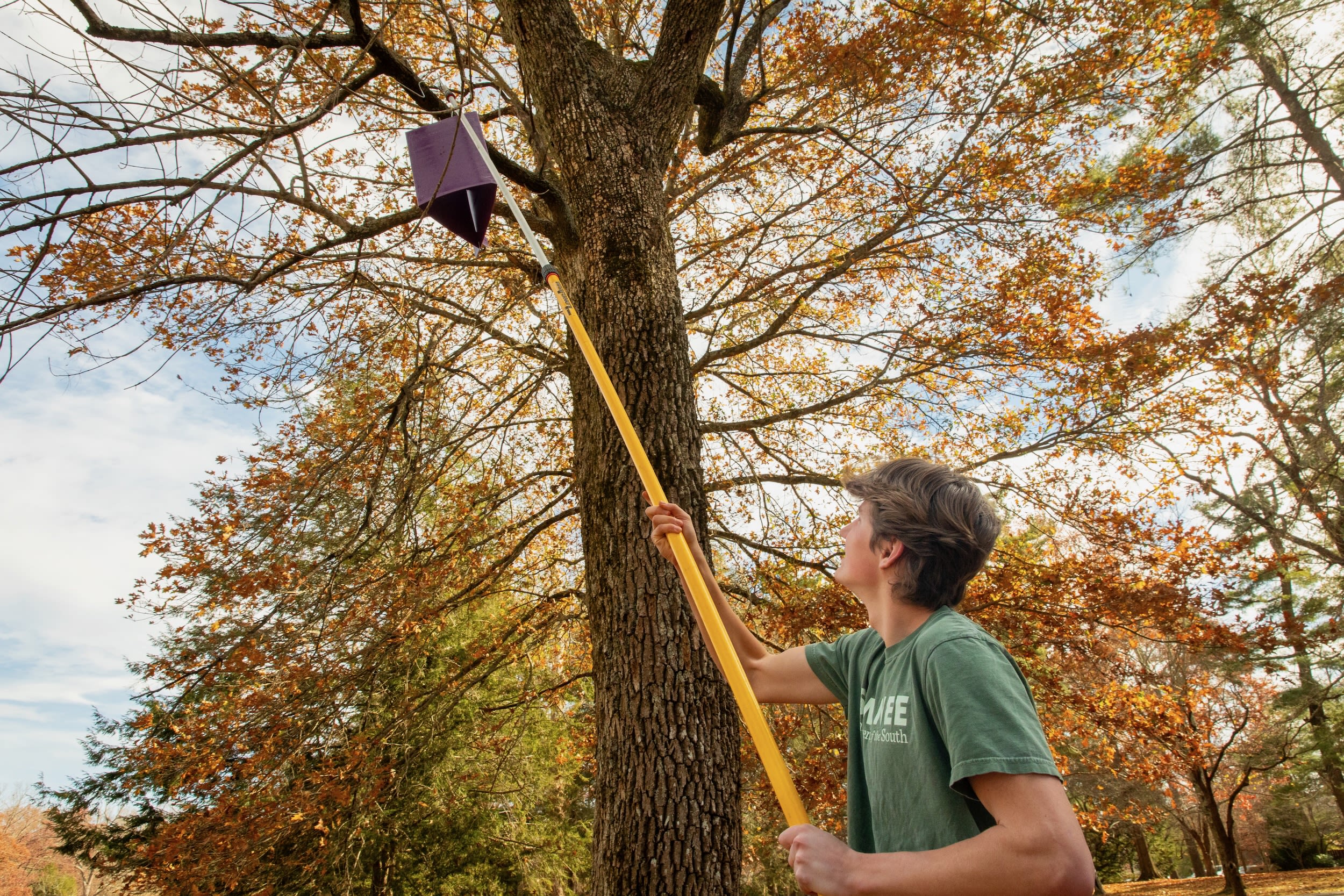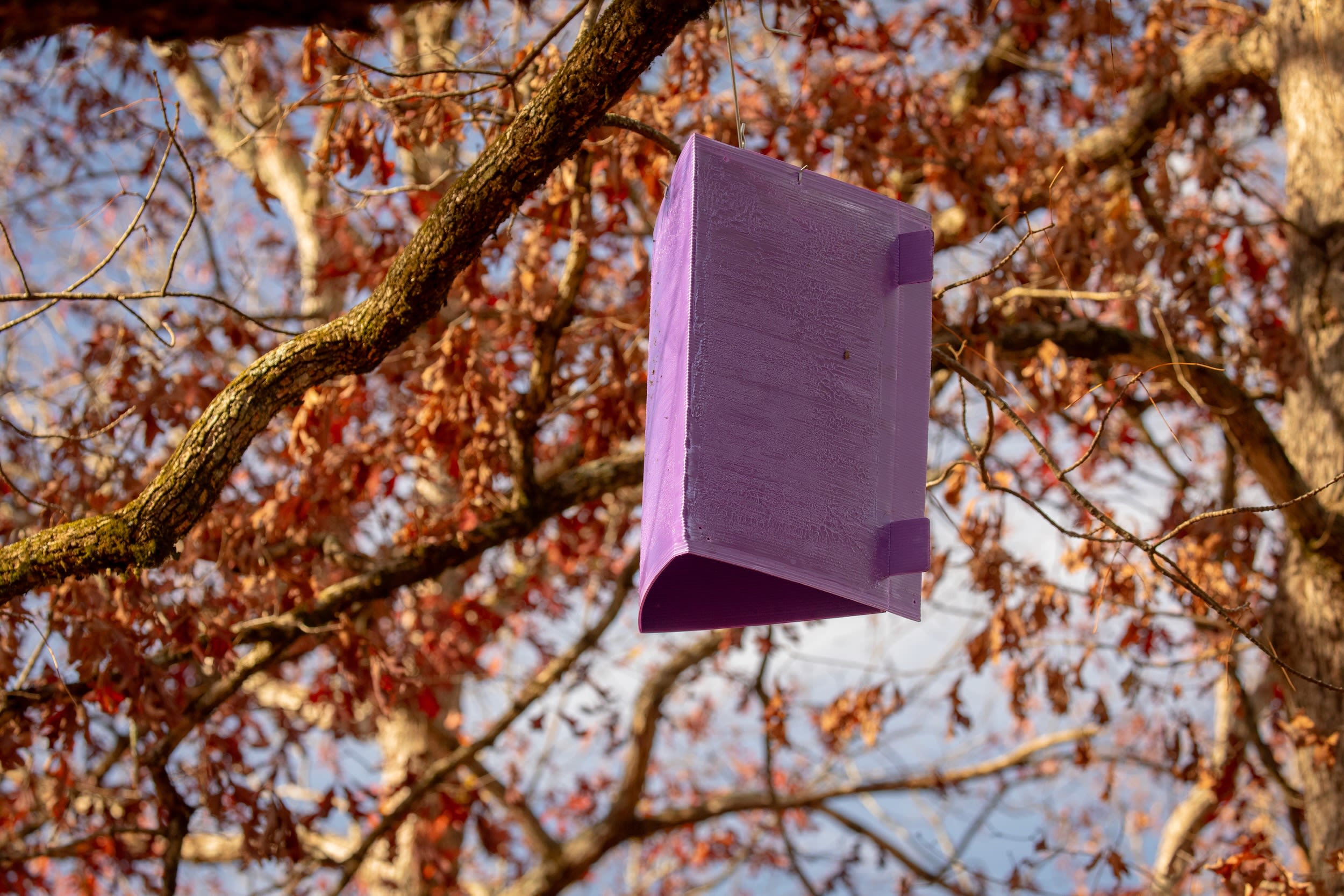Wasp Whisperers
Student interns with Sewanee’s Office of Environmental Stewardship and Sustainability work with an insect army to help save the Domain’s population of ash trees from an invasive pest.

Each fall, as summer’s heat is gradually replaced by autumn’s chill, Sewanee is accustomed to seeing its community grow. Among the traditional new members are 450+ new students, as well as new faculty, staff, and new Domain residents. Yet this fall, Sewanee’s newest occupant stood out as particularly distinct. It had a set of antennae, a pair of wings, and was roughly the size of a mosquito—and it was here to help safeguard some of Sewanee’s oldest residents.
As part of a summer internship like no other, a team of students spent the summer traversing the Domain to release a new species of wasp into its environs. The wasps, they hoped, would help to curtail the threat posed by an invasive pest with the potential to decimate Sewanee’s entire population of ash trees: the emerald ash borer. The culmination of a coordinated effort between University students, employees, and the U.S. Department of Agriculture, this endeavor marked a major step toward securing a safer future for one the Domain’s most beautiful assets. And in success, they just might have saved some of its legacy flora, ensuring that they endure for the next generations of Sewanee residents to enjoy.
An Emerging Crisis
Named for its striking green color, the half-inch-long emerald ash borer takes out ash trees with ruthless efficiency. Adult borers begin by laying their eggs on an ash tree. After hatching, the young larvae then crawl around beneath the tree’s bark and feed on its tissue, depriving it of needed water and nutrients and eventually killing the entire tree.
Native to eastern Asia, the emerald ash borer was first spotted stateside in 2002, in southeast Michigan. It is presumed to have entered the country within wooden shipping and packing materials (e.g., crates and pallets), and quickly spread throughout the Eastern U.S. It has since been confirmed in 36 states, with the first known sighting in Tennessee occurring in 2010 and the first in Franklin County recorded in 2015.

The half-inch-long emerald ash borer was first seen in the United States in 2002, and in Sewanee in 2021.
The half-inch-long emerald ash borer was first seen in the United States in 2002, and in Sewanee in 2021.
It was a matter of when, not if, the emerald ash borer would arrive on Sewanee's Domain, with that inevitability coming to pass in September 2021 when a green ash tree with borer damage was identified in Manigault Park. We’ll probably never know exactly how it made its way to Sewanee. Most likely, it took a path similar to how it came to the United States to begin with—unintentionally introduced to a new environment through wood packing materials or via firewood brought to the Domain for recreation.
Responding to the Threat
With the emerald ash borer confirmed to have arrived on campus, the situation took on a new urgency. Though the borer had initially been spotted on central campus, attention quickly turned to more remote areas of the Domain with the densest populations of ash trees: Shakerag Hollow, Dick Cove, King’s Farm, and Armfield Bluff. Left unchecked, the emerald ash borer could eventually destroy the ash trees present at all of them.
To forestall that chilling possibility, the Office of Environmental Stewardship and Sustainability (OESS) team sought out the support of the U.S. Department of Agriculture, applying to participate in the Animal and Plant Health Inspection Service’s (APHIS) biocontrol program in November 2022. Biocontrol, or biological control, is a pest-control method that relies on naturally occurring enemies like predators or pathogens to reduce a given pest’s population. In the case of the emerald ash borer, four parasitoid wasp species native to China were identified as biocontrol agents.
Each about the size of a mosquito, the stingless wasps are remarkably effective at reducing the number of emerald ash borers in a given area by parasitizing borer larvae and eggs. Because the wasps are not indigenous to the United States, they have to be specially reared at a facility in Michigan—a time- and resource-intensive process, and one that limits the number that can be distributed in any one year. In a stroke of good fortune, Sewanee was selected in early 2023 to receive 2,800 wasps for release during the summer.

Graham Nystrom uses a telescoping pole to install a borer trap in an ash tree in Manigault Park.
Graham Nystrom uses a telescoping pole to install a borer trap in an ash tree in Manigault Park.
Getting to Work
With a finite number of wasps secured and a wide area to consider, it was essential that the wasps be deployed strategically to maximize the likelihood of success. A team of students dispersed across the Domain, helping to quickly ascertain the relative spread and abundance of the emerald ash borer and ultimately inform the later release of the wasps.
Among the students involved in the early scouting was Graham Nystrom, C’26. Equipped with a set of GPS coordinates, rope, and an extendable telescoping arm with a hook on its end, Nystrom spent the spring placing emerald ash borer traps at various sites on the Domain. The purple, triangular traps contain both an attractant lure and sticky material to entrap the borers.
Placing them was no simple assignment. After arriving at the designated coordinates for a given area, Nystrom’s first task was to determine the best site at which to set the trap. Drawing on tree identification skills gleaned from forestry coursework and training from his position as an ecological research technician in OESS, Nystrom had to find an ash tree that was still alive, healthy, and that would allow a trap to hang at least 15 feet in the air while dangling as close to the tree’s trunk as possible.
After the traps had been laid, the summer team stepped in. Sarabeth Bivins, C’24, and Sam Ude, C’26, interned with OESS and started the summer by trekking across the Domain to the various trap sites. At each one, they took a count of how many ash borers had been caught.
Getting to the actual sites, however, was itself a bit of an undertaking. With the locations having been dictated by the Domain’s specific pattern of ash tree density, most were decidedly off the beaten path and inaccessible via established trails. “We would go as far as we could on the trails,” says Ude, “and then we would have to hike—sometimes over a mile—down the bluffs and back up again to check the traps.”
The wasps began arriving in Sewanee via small shipments over the course of the summer. On those days, Bivins and Ude would assemble their needed equipment and hike back out to that week’s designated trees to release the wasps.
“We would also do a reading of the state of the tree,” says Bivins. “We’d check to see if there were exit holes from the borer, if there was any splitting, and looked at the general health of the canopy.” Their collected measurements would eventually be shared directly with USDA APHIS as part of the larger biocontrol program’s requirements.

The three-sided purple traps are covered with sticky material to trap the borers.
The three-sided purple traps are covered with sticky material to trap the borers.
Looking to the Future
For Bivins and Ude, the rigor of the days spent outdoors seeking out terrain unknown to most Sewanee visitors made for a summer internship that was somewhat extreme—but also extremely memorable. In addition to the summer heat and the miles walked, there were also the regular tick checks, vigilance for poison ivy, and encounters with wildlife keeping things interesting.
The experience also provided all of the involved students with a unique opportunity to engage in true fieldwork outside the classroom. “The measurements these students took at release sites had to be reported to USDA APHIS within 48 hours,” says Kevin Fouts, wildlife manager at the University. “They weren’t just doing an exercise to learn a skill—what they did in the field mattered to many people in an immediate and big way.”
Bivins, a biology major who hopes to go into conservation and fieldwork, found it to be an unparalleled opportunity to get a taste of what her future could entail. “It definitely feels different [than doing labs in class], because a lot of the time you’re running tests or things that have already been done,” she says. “But with this, it was very much, ‘We have no idea what you're going to run into out there. It's your job to figure it out.’ That was exciting.”
Adding to the excitement: While this was the first part of what will be a long-term effort, the early signs are encouraging. Emerald ash borer counts taken at the end of summer and early fall suggest that the introduction of the wasps to the Domain may have done more than simply create a safer environment in which new ash trees can grow—it may also have managed to save a number of the Domain’s hundreds-of-years-old legacy ash trees, particularly around Shakerag Hollow.
The significance of that fact is not lost on the involved students, for whom the efforts to preserve the Domain carry great significance. “Some of these trees have been there for centuries. They’re part of our history,” says Ude. Adds Bivins, “I've spent the last four years of my life here, so it feels nice to be able to help out a little bit in any way I can.”
And while acting to preserve the natural beauty of Sewanee no doubt has immediate effects for the community at present, Nystrom is also hopeful about the wider-reaching value in prioritizing conservation efforts on the Domain. “I believe that if we can connect people with the outdoors, then that will do so much for the whole environmental crisis we're in,” he says. “I think that's the first step toward a much larger solution to other big problems.”
The parasitoid wasps mentioned in this article were produced and supplied from the U.S. Department of Agriculture’s Animal and Plant Health Inspection Service Plant Protection and Quarantine EAB Parasitoid Rearing Facility in Brighton, Michigan. For parasitoid information, please call 866-322-4521.
